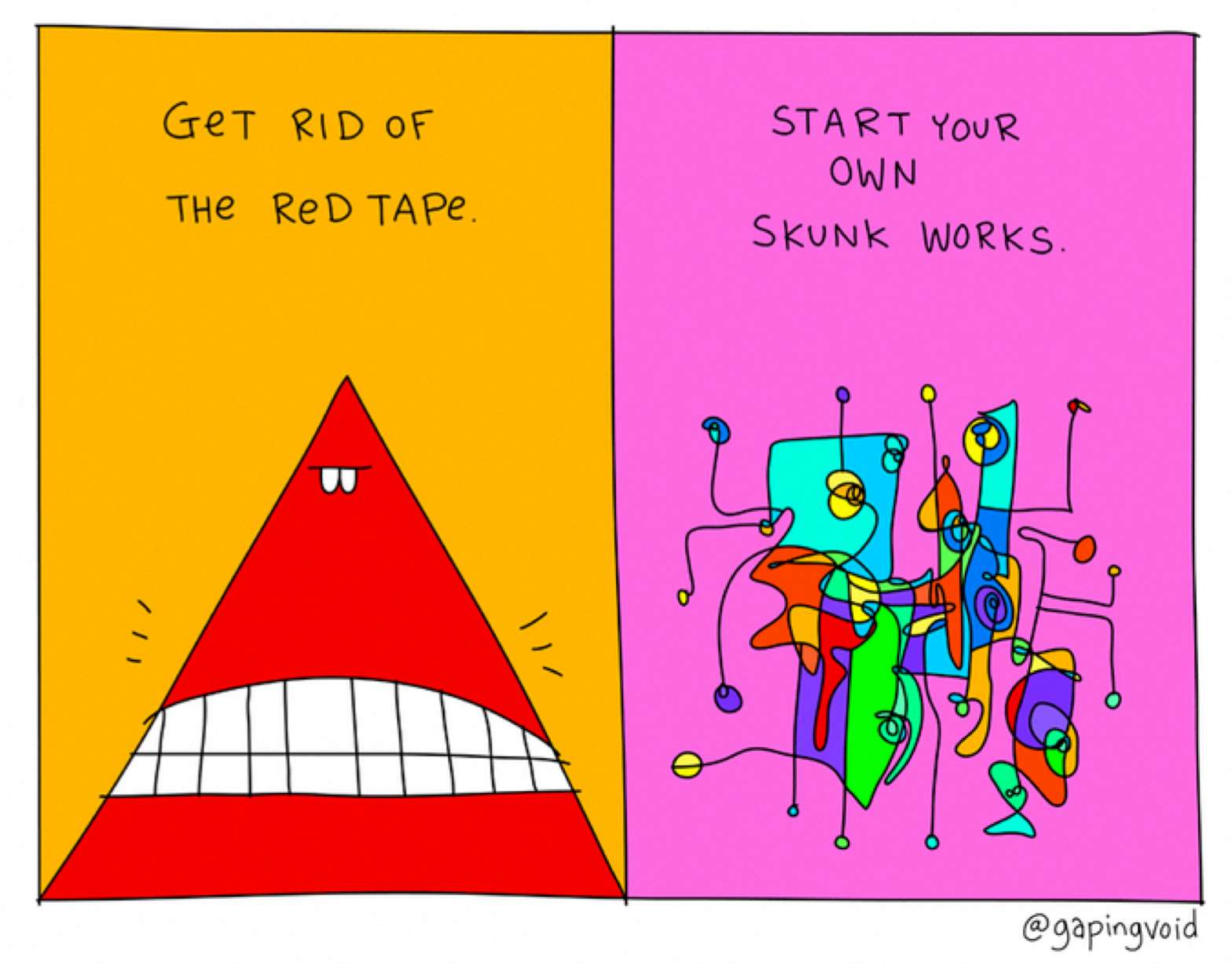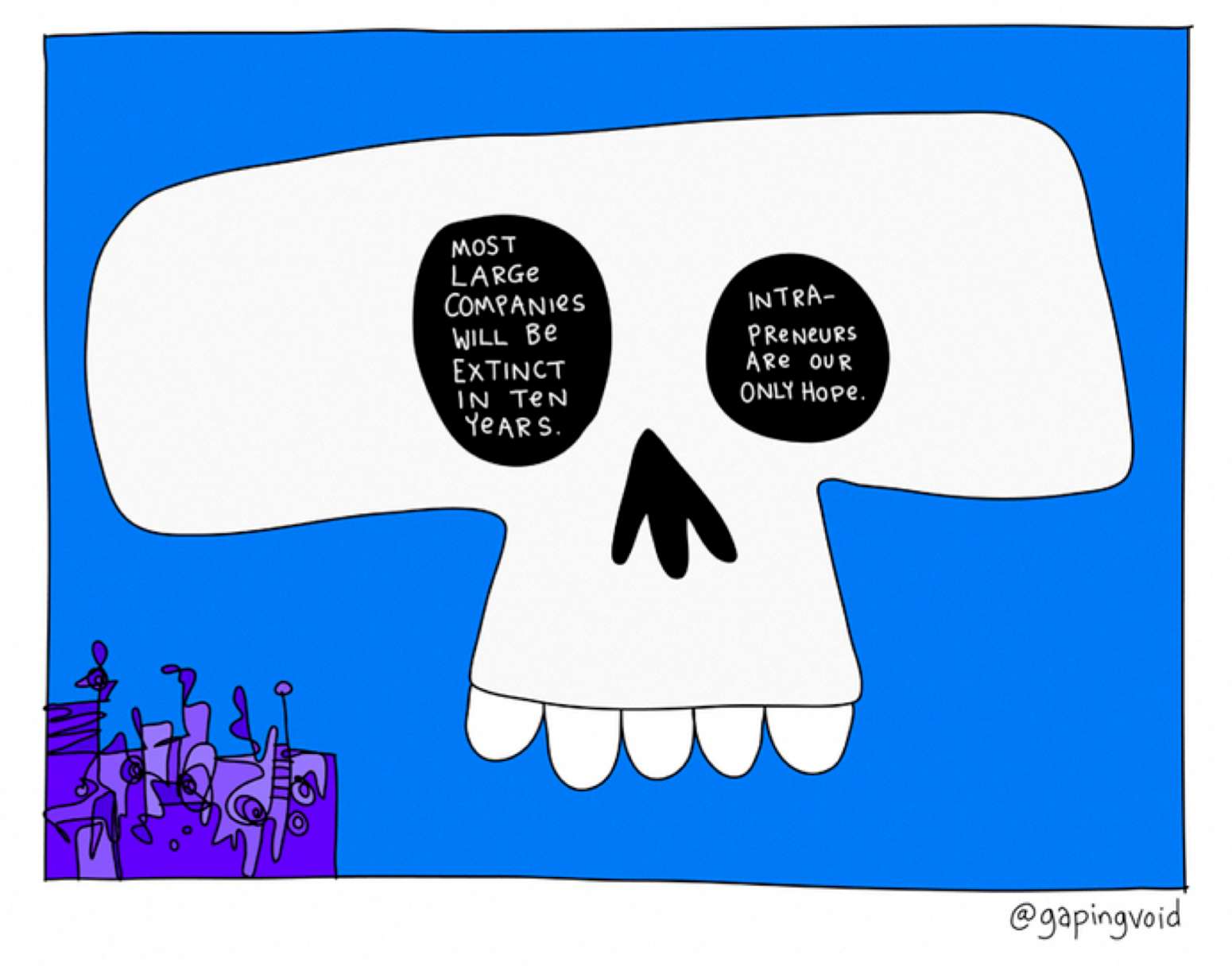According to Gapingvoid co-founder and CEO Jason Korman, context and socialization is the only scalable way to translate ideas into action.
 For a decade, Gapingvoid Culture Design Group has been designing and implementing engaging cultures at some of the most prominent companies on earth, including Zappos, LinkedIn, and AT&T. After attending #IntraCnf Toronto last November they created an illustrated ebook (download it here), capturing the key sentiments and takeaways, to help participants translate ideas into action back at their organizations.
For a decade, Gapingvoid Culture Design Group has been designing and implementing engaging cultures at some of the most prominent companies on earth, including Zappos, LinkedIn, and AT&T. After attending #IntraCnf Toronto last November they created an illustrated ebook (download it here), capturing the key sentiments and takeaways, to help participants translate ideas into action back at their organizations.
We love the results – but we wanted to know more about the process. So we called Jason to get his insight into how and why visuals – like illustrations and ‘silly cartoons’ – are powerful tools for enabling cultural change and innovation.
You guys did a great job at capturing the key takeaways and conversations from #IntraCnf Toronto in the book. How would you suggest I use it to facilitate conversations around change?
I attend a lot of conferences. There’s always a lot of tension between what happens at the conference and actionable steps you can take after you get back to the office. You’re behind on your emails. There’s been ten people wanting to get hold of you. The last thing you’re thinking about is ‘how do I spread all this new learning and insight?’
The book is designed to help you do that. It’s deliberately an ebook as opposed to anything you might get through the post. We want you to share it and send it around to your team. We wrote the book after the conference; a lot of the illustration was done during the event, but a lot of the insights came after. What we do is we sit down with the ideas and notes from the conference in a group and we talk through them, looking for the nuggets. What it did all mean?
The whole idea behind these wacky but compelling images is to help you have a conversation that you would never have otherwise.
To provoke memories of the event, reminders of the things that struck you and made you think ‘oh, I can’t forget that when I get back to the office.’ Inevitably, you do forget. It’s designed really as a trigger to help you re-experience the really valuable parts, and share them with your team.
We often hear that people print them out and share hard copies, which is fine too. A problem we’re all facing right now is that we have so much digital stuff on our computer, we have so much coming at us. In the old days, the early 2000s, digital was the answer to everything. Now, there’s so much crap coming at us digitally that hard copies are, in many ways, more valuable. They’re always there. They might be sitting on your desk for a week or two, but you’ll pick it up and read it. Whereas something else might be way down the list in your download file, you won’t even remember you have it until a few months from now when you’re cleaning out your downloads.
 You’ve said that you use art as a means to an end. Can you tell me a bit about the role of art in triggering these conversations and achieving goals, like culture change?
You’ve said that you use art as a means to an end. Can you tell me a bit about the role of art in triggering these conversations and achieving goals, like culture change?
Over the years we’ve developed what we refer to as the Gapingvoid Culture Change Model, which is based on a few things. Ed Schein’s work at MIT: he was the first professor to really dig into culture from a scientific perspective. John Kotter’s work over at Harvard: Kotter’s Change Model is the gold standard of change management, B.J. Fogg, who runs the Behavior Design Lab over at Stanford. We’ve spent a ton of time, especially with B.J. recently, digging through and trying to understand what is it about these models that work? What can you borrow from them to help construct a model for culture change?
The reason people are really uncomfortable with culture, we think, is because a lot of it does feel super-soft. When you talk about shifting mindsets, changing behaviors and beliefs, it feels very unbusinesslike to a lot of people. What you have to do is create a structure that is the opposite, that is connecting and has a clear methodology behind it.
Culture change is really a euphemism. It could mean creating a better environment for innovation, or it could mean creating a better broad organizational culture, or it could be about digital transformation…it could be about a million things.
Ultimately, you’re looking to change people’s beliefs about something and then give them a way to execute.
What it really comes down to is setting a vision for the future, which is obvious. Everybody talks about mission, vision, that future state you want people to achieve. That’s the motivator for people. That’s when people go, “Yes. That makes sense to me. I want to be part of that.” Then, what you need to have – and this is where it starts to get gnarly for some people – is a clear set of articulated beliefs. The standard culture version of that is a list of core values, but it’s really a belief system. It should be very robust and very broad about how you shift people’s perception and understanding of what’s important and what’s valued.
Then, if you make it through the articulated belief piece, the last piece is socializing your motivating factors and articulated beliefs. This is the most difficult piece for most folks.
Socialization comes from communications. It comes from visualizing that future state and from those articulated beliefs.
So when we talk about “art”? Art is that last piece. It’s how you socialize and get people to share that desired future state. In the absence of that, it never is going to happen. Maybe you see a goofy drawing or illustration from us and think it’s silly, or it’s just a cartoon.
No. It’s a tactic. It’s a tool, a device for spreading and sharing those ideas. Without that device, nothing changes. It’s the trigger for change.
For example, you cannot have a political party without these visual tools – cultural artifacts, totems, social objects – that represent and spread the message, and drive the behavior and the mindset. Every religion has these tools. You can go back to the beginning of time, it’s always been that way. Any big brand, same thing. There’s a look and other visuals they attach meaning to, and that spread the mindset and message of that brand. The messages these tools represent become integrated into our lives.
The problem for most people in business, especially in enterprise, is when you to get to the visualization and the articulation piece, everything starts to fall apart. It doesn’t feel comfortable because they think it’s not about data. The way we do it, it’s all data driven. Our goal is to make it data driven, but feel really soft and friendly and cool. That’s, I think, the interesting rub there.
 What I think your work does particularly well is shine a light on the things that we all sometimes think or feel, but aren’t able or willing to share openly. Would you agree?
What I think your work does particularly well is shine a light on the things that we all sometimes think or feel, but aren’t able or willing to share openly. Would you agree?
Hugh, our chief creative, is remarkably skilled at outing the things that we all think about and maybe are even a little scared about, but never talk about. The elephants in the room, so to speak.
But it’s talking about these things that really drives a lot of change. Basically saying to everybody: “Look. There’s all this crap going on. We don’t feel comfortable talking about it. If we take five minutes and just acknowledge that it exists and we need to fix it, we’ll make a lot of progress.”
Years ago, we worked on a project for a big healthcare system. Seven years prior, they had laid off 750 people in the worst possible way: a Friday afternoon, key cards locked out, emails terminated before anybody was even told. It was a disaster.
Seven years later, it was still a huge bone of contention with all the remaining employees – and there were 15 thousand employees. Because the company had never dealt with this, everybody felt uncomfortable and unsafe. We went in there and said, “Look. Let’s socialize the idea that that was a mistake. We own up to it, and we have to move forward. It’ll never happen again.”
Until that happened, it was the thing no one ever talked about. It’s crazy. It happens every day in companies.
Exactly. That’s also the conversation we aim to have at our events and why we love your work. The Toronto book in particular focused on innovation. In your experience, how does culture impact innovation?
The Toronto book provides tools to interact around innovation in a way that, I think, will engage and get through to people who still don’t get it. A lot of innovation is about strategy. A lot of it is opaque and hard to understand and feels risky. You have to reframe all that through conversations, especially with the people you struggle with. I think the book is a great way to do that.
I think this innovation problem in large organizations is, first and foremost, a cultural problem. Do we all believe the same thing? Do we all agree on where we’re going?
I was on a panel last week at an oil and gas conference and I asked, “Who in the room is talking about how solar and wind is going to disrupt you and put you out of business? Is that a conversation you’re actually having? Or are your solar people and wind people off somewhere else doing their own thing?” Everybody just looked uncomfortable when I said it.
The truth is, the world is changing. I think in the last ebook we did for you, we created an image of a snake eating its own tail; basically saying, “Look. Either you’re going to disrupt yourself or somebody else is going to do it for you. You’re better off doing it yourself.” If you’re an enterprise and you’ve got a huge amount of value and a lot of livelihoods riding on what you already have and own, then that disruption thing feels really uncomfortable. But you have no choice, because it’s not like it used to be where you build something and it’s good for 40 or 50 years.
No. You build something, it might be good for four or five years. I think for a lot of folks, that is a huge challenge internally. None of the entrenched stakeholders really want to have that conversation. They just want things to go on exactly the way they are.
Then, you have the situation that most change projects fail. The number is like 70%. Why? Because we pretend like people aren’t people.
You’ve got to meet people where they are, and you’ve got to be willing to engage them in a way that connects their emotions and their intellect to what needs to happen, to that desired future state.
I think that the people who are successful in innovation really understand that and take it head on. In the absence of that, you’re never going to get innovation. Ever.
DOWNLOAD MUSINGS OF CHANGE – LOOKING BACK AT INTRACNF TORONTO HERE

